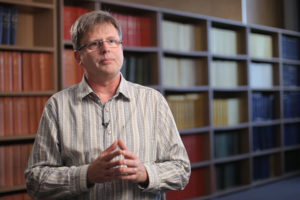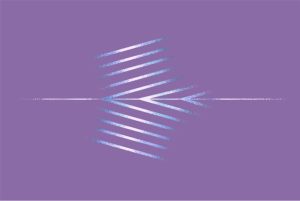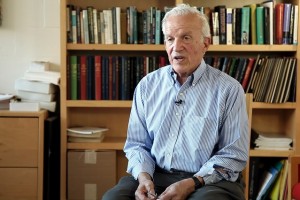Metamaterials and Invisibility
Physicist Martin McCall on Maxwell's equations, hiding objects with light, and invisibility cloaks
What does it mean to have a spin equal to one half? What is the missing piece in the Standard model? How can we understand fundamental particles better? These and other questions are addressed and answered by Associate professor of Physics and researcher at the Laboratory of Mathematics and Theoretical Physics at the University of Tours Xavier Bekaert.
A ‘spin’ in English means a particle, an object when it rotates around itself. It’s a particular example of what physicists call angular momentum. Angular momentum is the way physicists describe the rotation of physical objects. Essentially, there are two types of angular momentum. One when two objects rotate one around the other, like the Earth rotates around the Sun: this is called orbital angular momentum like the orbits of the planetary motions. But spin is different, spin is a rotation of an object on its own axis, so for instance, the Earth turns around its own axis while it turns around the Sun, so this is what we mean by spin. Strictly speaking, what I just said is just classical spin while for elementary particles you need to know what is quantum spin because the elementary particles are quantum objects which is something not so easy to explain in familiar terms, but I’ll try to do my best.
Maybe the best way to imagine elementary particles in modern terms is like what physicists sometimes call quantum tops, – these objects that children make to turn around themselves – and in a sense no matter what you mean by ‘quantum’, elementary particles are some sort of infinitely small quantum tops. It’s a bit hard to say more. So what physicists learned is that all elementary particles’ motion is characterized by two quantum numbers: one is maybe more familiar, the mass, and the other one, very important, is indeed the spin. So now we know that spin is a very important property of elementary particles.
So that’s matter. Then there are also very important elementary particles called gauge bosons. These particles have the spin 1, and they are mediators of fundamental interactions. So there are gluons, maybe more familiar photons that transmit the information about electromagnetic force, light in particular, and then we have more exotic ones, like W- and Z-bosons. These are most of the particles that we know already for some time, from the 70s and so on, and recently the Higgs particle was discovered. Strictly speaking, it should be called Brout–Englert–Higgs particle because two Belgians were forgotten in this name, but that’s another story.
So the Higgs boson is the only particle that has spin equal to zero. It means that it can turn around itself, you can make any angle around it and it still looks the same, so it’s a spin 0 particle, while the gauge bosons have spin 1: that means that they should make one turn to look like themselves. It’s a little bit like an arrow: you need to take one turn so that the arrow points in the same direction.
All this is an experimental physics, what has been observed. But I’m a theoretician, so we would like to go further, beyond what has been observed which is what is called the Standard model of particles. There are theories that has been proposed to go beyond the Standard model. A very important piece that has been missing in the Standard model is gravity. Gravity is described by general relativity since the work of Einstein, and if you try to describe gravity like we are used to describe elementary particles, then you are led to the idea that in principle this fundamental interaction should also be described in terms of gauge boson. We call it graviton (‘gravity’ – ‘graviton’).
But this strange gauge boson should have spin equal to 2 for some complicated reasons: it’s enough to make half of a turn so that the graviton looks like itself. This is a property of gravitational waves described in quantum terms. In other words, if we want to quantize gravity, we need to describe particles which are massless (that’s also a bit strange because gravity propagates at the speed of light, so it should be massless) and should have spin 2.
This is what sometimes is called nowadays the spin two barrier because if you try to describe it like we did for spin 1 particles, everything blows up, all your equations provide infinities, and it’s difficult to make sense of it.
Of course, it’s one of the major theoretical problems of physics of the 21st century: to try and quantize gravity.
Since it’s very difficult, you need new ideas. One of the first ideas that’s been proposed in 1976 was supergravity. The idea was to supplement graviton with a particle that really is also very exotic which has half-integer spin (most similar to the leptons and quarks) which is called gravitino, like ‘the neutrino’ (which also has spin 1/2: it is a particular example of lepton). So the gravitino has spin equal to 3/2, so it means that it has to make 2/3 of a turn so it looks like itself. This is supergravity; it works, it has some success, but still, unfortunately, it’s not complete, so the supergravity can be seen as an approximation of what would be the superstring theory but on lower energies.
But the string theory contains particles of even higher spin than 2, so it seems that one possibility to solve the spin-2 barrier problem, this major problem of quantizing gravity, theoretically, speculatively speaking, at the level of equations, is that you need to go even beyond two. And most surprising is that once you go beyond two, you need all the spins together: two, three, four, five, six, seven, without any bound on the spin. This is also very strange, but it works very well at the level of the equations.
That’s what the string theory does: among the particles that the string theory predicts you have indeed particles of higher spin, but in string theory they are massive particles, their masses are not zero, not like the graviton and the photon which propagate at the speed of light. So all these particles predicted by the string theory go slower than the speed of light.
But the experience that we have about fundamental interactions like electroweak interaction tells us that to understand better the theory of fundamental particles we need to probe it at higher and higher, extremely high energies, and at very high energies particles look like massless. This suggested in the 80s the idea that maybe we should look at the extremely high, so-called ultra-planckian energies of string theory in which case all these higher spin particles are massless.
And then it’s really like a dynasty. A PhD student of Ginzburg, Efim Fradkin, who was really quite and impressive scientist, also contributed to the supergravity, but he was one of the first to push forward trying to build a theory of interacting particles of spin greater than 2 which are massless, so a higher-spin gravity. He was not alone in this big quest: he was also with his student Mikhail Vasiliev who is still now at ФИАН, the Lebedev institute, and Fradkin had also other students who contributed to different directions of the theory like Ruslan Metsaev and Arkady Tseytlin. These are very well recognized scientists, but there are also a younger group at Lebedev, and people who originate from this group really do a great job. So for sure, Russia has a long tradition in this area, and that’s why it’s always very important for us in this higher-spin community to be able to interact with Russia and enjoy Russia.
Among the hopes that I still have about this higher-spin gravity is that I think that among the two major problems that remain to be solved, one is presumably trying to clarify what is the underlying geometrical structure. Some understanding exists, but I think the big picture of the geometry is still missing. The great success of the general relativity was that it could provide geometric view on gravity, so it was a unification of some thing that was a priori of more mathematical nature (invented by Riemann and other great geometers) and really very physical property, the fact that all objects independently of the mass fall exactly in the same way, with the same acceleration. Something similar should exist for higher-spin gravity, and it’s presumably one of the keys that are missing to really open the door of deeper understanding, and people in this community are dreaming of taking a step in this direction. This is the first very important point.
The second point which really remains to be better understood is how to go from massless particles to the real world where actually they are massive because we don’t observe them. If they exist, they should be very massive, beyond the access of the present day experiment. This is what we call ‘spontaneous symmetry breaking’, and what is missing is something similar to what is called the Brout–Englert–Higgs mechanism. This piece is missing also about the higher-spin gravity. So before we will be able to make contact not only with nice theoretical models but more concrete things, we need these two things presumably to solve it.

Physicist Martin McCall on Maxwell's equations, hiding objects with light, and invisibility cloaks

Physicist Markus Morgenstern on weak topological insulators, 2D materials, and spin pumping

Prof. of MIT Daniel Kleppner on the uncertainty principle of quantum mechanics, the butterfly effect, and &la...